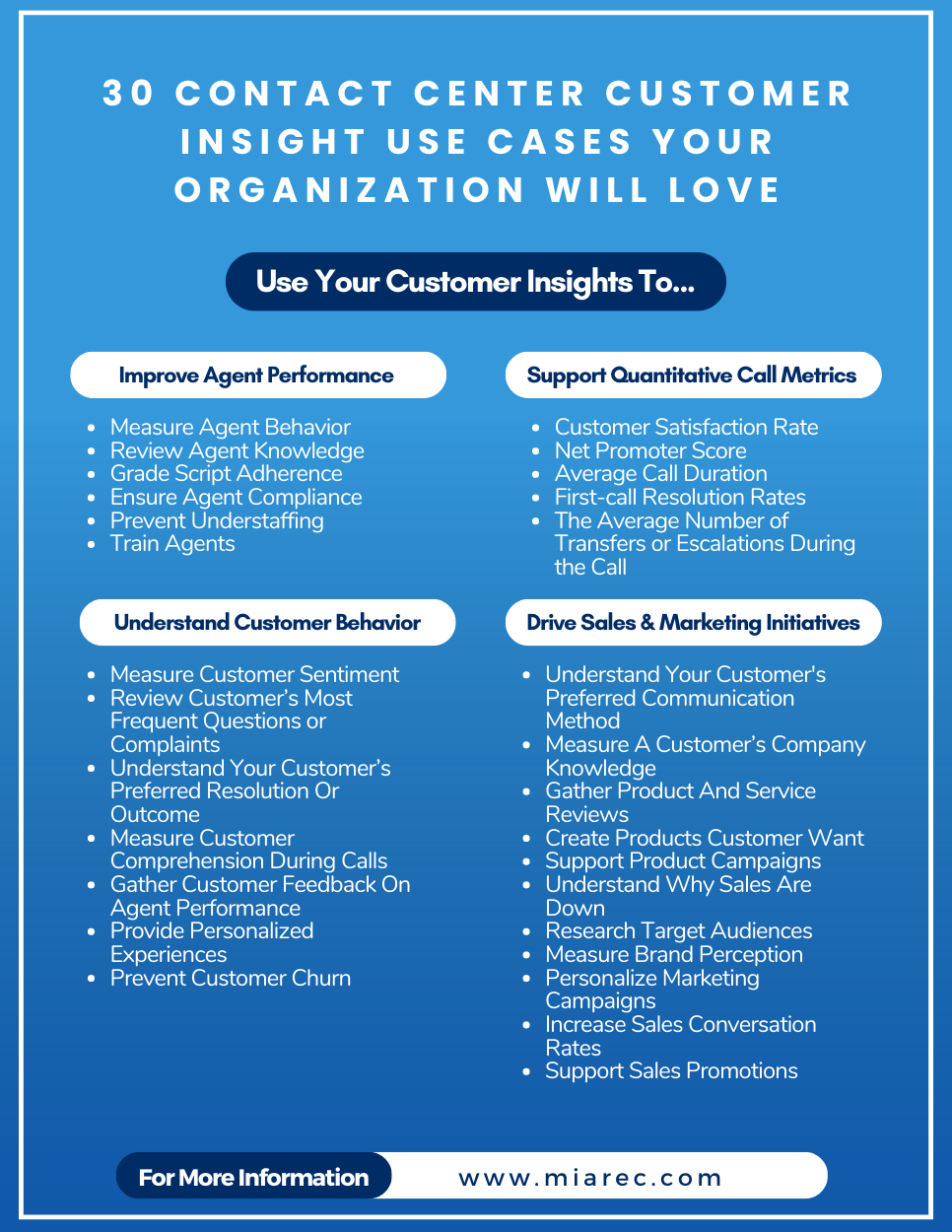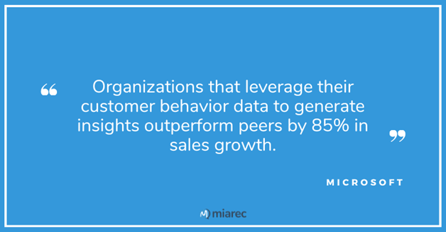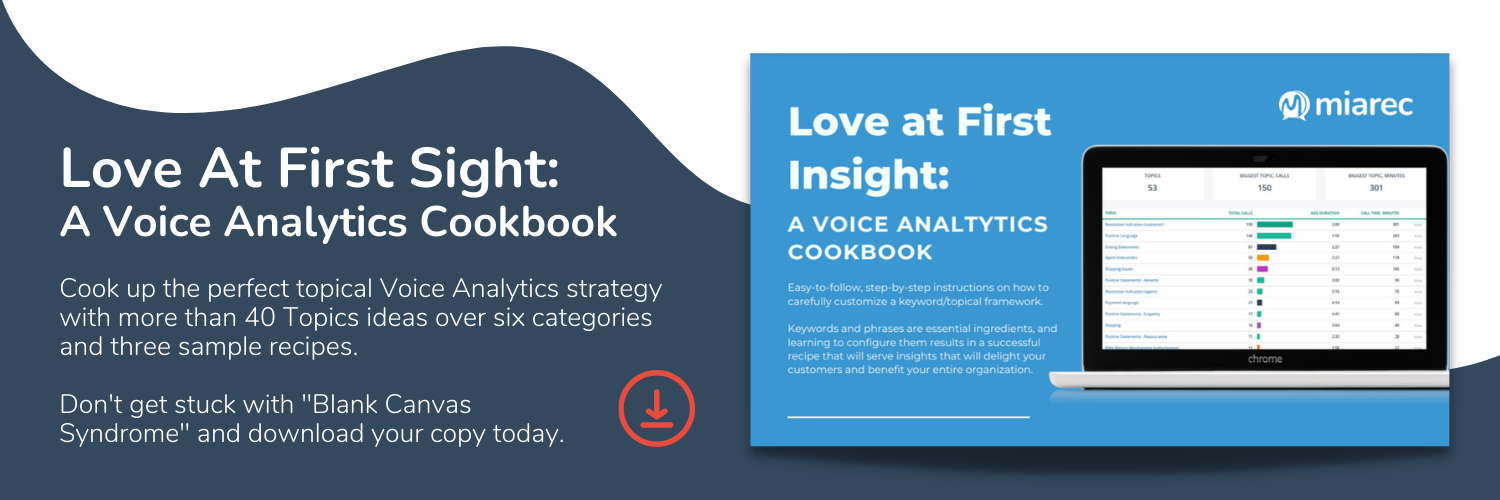30 Contact Center Customer Insight Use Cases Your Organization Will Love
As you consider Voice Analytics solutions for your contact center, you want to ensure you use it to its fullest potential. Voice Analytic solutions can analyze your calls for valuable customer insights that can improve agent performances, drive sales and marketing initiatives, and improve customer experiences. How can you be sure you are making the most of your customer insights?
MiaRec has provided Voice Analytics and AI-powered Automated Quality Management solutions to hundreds of contact centers. We have helped our customers detect customer insights that address their specific business needs.
In this article, you will learn how to utilize Voice Analytics to gather customer insights. By the end of this article, you will have 30 ways to apply customer insights to drive business goals, improve contact center workflows, and more.

What Are Customer Insights?
Customer insights are the trends and patterns gleaned from your consumer data, such as consumer preferences, habits, and more. Contact centers typically gather consumer insights through customer surveys or Voice Analytics software.
However, most customers will not stay on a call long enough to fill out a survey. For example, post-call survey rates are historically low, some sources report that less than 5% of consumers will fill out a post-call survey.
Your contact centers likely have more agent-customer interactions than customers filling out surveys. Most customers will choose to reach out to an agent for product or service inquiries. Your agent’s calls contain valuable data that could help you better understand customer behavior, improve call performance, and drive business decisions.
How To Use Voice Analytics To Gather Customer Insights
A Voice Analytics solution evaluates calls for customer insights. Most Voice Analytics solutions offer features such as Sentiment and Topics Analysis to organize and analyze calls for meaningful insights to improve customer experiences. These solutions could also provide automated call summaries, agent coaching, or additional features to help contact centers make the most of their data. In this section, we will be focusing on three helpful Voice Analytics features, Topic Analysis, Sentiment Analysis, and Automated Call Summary, and how they are used to gather customer insights.
What Are Topics and Sentiment Analysis?
Topics Analysis categorizes calls by topics, or customizable keywords and key phrases. Organizing your calls by topics can make it easier to locate calls on specific subjects, detect trends and patterns, and understand why your customers are calling.

Image: Screenshot of MiaRec Topic Analysis and Topic categories. Topics such as “Lack of Knowledge” can highlight gaps in the agent’s knowledge and ways to improve.
After organizing your calls by Topic Analysis, you can use Sentiment Analysis to detect and visualize customer sentiment. For example, the image below demonstrates MiaRec Sentiment Analysis. Under the Sentiment Scores are Topics and Keywords. Topics analyze call transcripts for your preferred keywords and key phrases. It then categorizes these calls accordingly. In this call, the customer had mentioned they had a "problem". This call would be grouped with other calls where the word “problem” was mentioned.

Image: Screenshot of MiaRec Sentiment and Topics analysis. MiaRec Sentiment Analysis highlights both Agent and Customer scores. This provides an overview of how the agent performed and how the customer felt throughout the call.
By utilizing Sentiment and Topic analysis together, you gain a better understanding of how customers feel about your agents, organization, company processes, products, and more. Was the customer upset because the agent did not know how to answer a question or because it was an answer the customer was not happy with? These insights can not only improve agent and customer call experiences, you can also share customer insights with the rest of your organization to drive business goals.
What Is An Automated Call Summary?
Contact center agents typically take notes throughout calls to turn them into call summaries. Call summaries note why the customer was calling, how the call was resolved, and any additional call highlights. An automated call summary solution streamlines this process, allowing agents to focus on the customer. At the same time, supervisors can still access call summaries to understand the customer’s concerns, how the agent handled the call, and more.
How To Use Customer Insights For The Best ROI
As you use your Voice Analytics solution to gather customer insights, how can you use these insights to get the best ROI? We have compiled 30 ways to use customer insights for organizational success.
Customer Insights To Support Quantitative Call Metrics
Quantitative call metrics numerically measure customers calls and behavior. They typically ask questions such as, “On a scale from 1-10, how do you feel about ‘X’?” They are popular for their convenience, but this convenience also means they do not fully encapsulate agent performances. By only using numbers to score agents’ calls, you are missing out on the nuances of the agent’s performance, the customers’ problems, and more. Voice Analytics does not always directly measure quantitative call metrics, but they can expand upon these metrics to provide a deeper understanding of your customer calls.
Customer Satisfaction (CSAT): For example, a CSAT score measures how happy a customer is with your products or services. It is often measured through post-call surveys that ask, "On a scale of 1-5 (from very unsatisfied to very satisfied), how would you rate your overall satisfaction with the product/service you received?" A Voice Analytics solution would not ask the same question, but it would analyze calls where customers discussed existing services, faulty products, and more. You can use Sentiment and Topics Analysis to understand how your customers felt about these products and services, whether they were happy or unhappy, their criticisms, and more.
Net Promoter Score (NPS): Contact centers generally measure how willing a customer would recommend their company to another person through post-call surveys that include questions such as, “On a scale of 1-10, how likely would you recommend our brand to another person?” However, you can also use Topic Analysis to track whenever a customer mentions someone had referred them or if they say that they would recommend your company to another.
Average Call Duration: How long are customers on the call with your agents? For reference, the global average call duration is 4 minutes. This may vary by industry. You can use your Voice Analytics to analyze particularly long or short calls to understand what caused the unusual duration. Was the customer suffering from a bad connection or did they hang up because they were unhappy? What caused the customer to be unhappy, and how did the agent handle the conversation? These are all questions that the Average Call Duration does not answer, but that you can use your Voice Analytics solutions to understand.
First-call Resolution Rate: Your first-call resolution rate is how often contact center agents solve customer concerns within the initial interaction. A high first-call resolution rate indicates that agents are effectively assisting customers on the first call. Use your Voice Analytics solution to measure high-performing calls to understand the most effective ways to address customers' concerns, what qualifies as a “good performance”, and more. These insights can be shared with agents to improve performances and encourage good first-call resolution rates.
Average Number of Transfers or Escalations During the Call: How often are your agents transferring or escalating calls? Depending on the call, agents will occasionally need to transfer callers to the appropriate department, but an unusually high number of transfers could indicate that there is a potential problem. For example, an agent could be constantly transferring customers to another agent when they do not know how to answer a question. You can use Topic Analysis to organize calls that include the word “transfer” to keep track of how often your agents are transferring calls.
Customer Insights To Improve Agent Performance
Quantitative call metrics are often used for their convenience, but there are additional aspects to consider when measuring an agent’s performance. You also need to consider their professionalism and knowledge, which are traits harder to quantify. With Voice Analytics, you can analyze your call transcripts for insights and data on how your agent interacted with the customer, how they resolved difficult conversations, and more.
Agents have a direct impact on customer experiences, which in turn affects how customers view organizations. Using customer insights to improve agent performances will lead to better customer experiences, nurture customer trust, and overall make customers happier.
Measure Agent Behavior: An agent must be professional and personable in order to de-escalate tense situations and build customer rapport. Use customer insights to see how your customers feel about your agents. Were customers already in a bad mood at the start of the call or did they become frustrated by an agent’s lack of knowledge? Analyze calls that include profanity to understand what caused a customer’s aggressive behavior.
Review Agent Knowledge: How much does your agent know? To answer customer questions, they must have adequate knowledge of your organization’s product or services. Depending on what industry your contact center is in, this could mean knowing how to transfer account ownership, close accounts, cancel services, recent deals or sales, and more. You can use Topic Analysis to grade calls by “Lack of Knowledge” to highlight any gaps in agent training. This ensures your agents are constantly keeping up with company policies, products, and services.
Measure Script Adherence: You can use customer insights to understand how well agents are following call scripts. For example, you might discover that agents are veering off script because the script is not answering customer questions as well as it could.
Ensure Agent Compliance: Measuring script adherence also means measuring agent compliance. You can use Topics Analysis to ensure agents are following company compliance policies. For example, are all your agents informing customers when a call will be recorded?
Prevent Understaffing: Sometimes, customers may mention over a call that they struggle to get connected with an agent during specific hours of the day. Supervisors can use these insights to schedule more agents at the appropriate time, preventing understaffing.
Train Agents: Assessing performance metrics such as agent knowledge and script adherence can help you better an agent’s actions and decisions. As you analyze customer interactions for agent performance, you can use these insights to drive personalized coaching plans and scale agent performances to meet customer expectations.
.png?width=433&height=135&name=image%20(21).png)
Image: MiaRec Sentiment Analysis being applied to a call transcript. Supervisors and agents can understand which phrases or sentences were rated positively or negatively.
Customer Insights to Understand Customer Behavior
Because customer insights are derived from customer data, they are a great way to understand customer behavior, expectations, and more. These insights can be used to drive marketing and sales campaigns, create products and services customers would like, support audience research, and more.
Measure Customer Sentiment: Some Voice Analytics solutions, like MiaRec, utilize the call transcript to show points of the call where the customer may have felt negatively. You can use Voice Analytics to review how customers felt during their call with the agent. What causes them distress? What leads to a good customer experience?
Review Customers' Most Frequent Questions or Complaints: You can use Topics Analysis to see how often customers call about the same question or concern. This will help you be aware of potential problems such as website bugs, declining call audio quality, or shipping delays, and you can address these issues before customer churn increases.
Understand Customers' Preferred Resolution Or Outcome: During the call, a customer may say, “I wish you could do…”. Set up specific Topics to track how customers wished a call had gone, what services you could offer, and more. This could help supervisors edit scripts to meet customer needs better. Organizations can also use this Topic to research potential services or products that customers would want.
Measure Customer Comprehension During Agent Calls: Use Voice Analytics to measure if your agents are communicating effectively. You can utilize Topics to track calls where the customers say, “I don’t understand.” These calls can be used to see if customers understand company policies and processes when the agent explains them. If they do not, then it may be time to review your call scripts.
Gather Customer Feedback on Agent Performance: You can set a Topic to find calls where a customer has commented on an agent’s performance. Boost morale by praising your agents when customers compliment their knowledge and professionalism.
Provide Personalized Experiences: Customer insights can analyze individual calls and caller needs, which helps agents ensure each customer gets a personalized follow-up experience.
Prevent Customer Churn: Customers are more likely to stay with a company that they feel understands and listens to them. Using customer insights to understand their preferred outcomes and provide personalized experiences will reduce customer churn.

Customer Insights For Your Company
According to Microsoft, organizations that leverage their customer insights outperform their peers by 85% in sales growth. Customer insights can help the entire company, not just your contact center. Here are a few examples where customer insights could drive marketing campaigns, improve company-wide communications, and more.
Understand Your Customers Preferred Communication Channels: You can set Topics to monitor how your organization’s other communication channels perform. Your customers could notify agents about the lack of self-service options, if email links were broken, if other employees were slow to respond, and more, during calls.
Measuring A Customer’s Company Knowledge: What do customers know about your company before going into a call? Are there services your organization already offers that your customers are not aware of? For example, many customers will call agents to ask about an organization’s return policies. Even if your organization has explained its return policy on its website, this information may not be easily accessible or clear to users.
Use Topics to discover any gaps in the customer’s knowledge of your organization. You can use this information to create effective chatbots, assist with website audits, and more.
Gather Product And Service Reviews: How do customers feel about your company’s products or services? Use Topics to track calls that mention products or services to ensure they are meeting customer expectations.
Create Products Customer Want: By listening to customer insights and developing products and services that customers want, you create an environment responsive to customer needs. When customers see that you are creating products and campaigns that resonate with them, they are more likely to invest in your brand.
Support Product Campaigns: When launching a new product or campaign, set Topics ahead of time to track customer conversations and measure your customers’ initial thoughts and reviews.
Understand Why Sales Are Down: When gathering customer reviews, customers are bound to have critiques and suggestions. Understand why sales may be low by reviewing customer calls that discuss your organization’s product or services.
Research Target Audiences: You can analyze your calls to better understand your current demographic. Your calls can help you research what kind of people are your most common customers.
Measure Brand Perception: Similar to measuring how likely a customer is to recommend your product, you can measure how customers perceive your brand. Do customers believe your company is only for a specific demographic? What can you do to change their perception of you?
Personalize Marketing Campaigns: As you better understand what customers want, you can deliver more personalized marketing campaigns that effectively target your ideal demographic.
Increase Sales Conversion Rates: By leveraging customer insights, businesses can tailor their sales strategies, messaging, and offerings to align with customer preferences and needs, thereby increasing sales conversion rates through targeted and personalized approaches.
Support Sales Promotion: Use Topics to notify contact center agents of targeted sales promotions. Agents can then alert customers during relevant calls. You can monitor results with Topics to track marketing campaign efforts.
Conclusion
You now have a comprehensive list of how your contact center can use customer insights to improve agent performances, exceed customer expectations, and reach business goals.
The sooner you utilize your customer insights, the faster you can boost customer loyalty and grow revenue. Contact our sales team to learn how to gather customer insights with a Voice Analytics solution.
Share this
You May Also Like
These Related Stories

Contact Centers Will Have To Evolve Drastically, Or Risk Being Left Behind

8 Contact Center-Generated Customer Insights Your Marketing & Sales Team Needs





